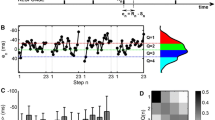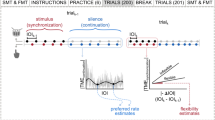Abstract
Recently, it was found that rhythmic movements (e.g. locomotion, swimmeret beating) are controlled by mutually coupled endogeneous neural oscillators (Kennedy and Davis, 1977; Pearson and Iles, 1973; Stein, 1974; Shik and Orlovsky, 1976; Grillner and Zangger, 1979). Meanwhile, it has been found out that the phase resetting experiment is useful to investigate the interaction of neural oscillators (Perkel et al., 1963; Stein, 1974). In the preceding paper (Yamanishi et al., 1979), we studied the functional interaction between the neural oscillator which is assumed to control finger tapping and the neural networks which control some tasks. The tasks were imposed on the subject as the perturbation of the phase resetting experiment. In this paper, we investigate the control mechanism of the coordinated finger tapping by both hands. First, the subjects were instructed to coordinate the finger tapping by both hands so as to keep the phase difference between two hands constant. The performance was evaluated by a systematic error and a standard deviation of phase differences. Second, we propose two coupled neural oscillators as a model for the coordinated finger tapping. Dynamical behavior of the model system is analyzed by using phase transition curves which were measured on one hand finger tapping in the previous experiment (Yamanishi et al., 1979). Prediction by the model is in good agreement with the results of the experiments. Therefore, it is suggested that the neural mechanism which controls the coordinated finger tapping may be composed of a coupled system of two neural oscillators each of which controls the right and the left finger tapping respectively.
Similar content being viewed by others
References
Daan, S., Berde, C.: Two coupled oscillators; simulations of the circadian pacemaker in mammalian activity rhythms. J. Theor. Biol. 70, 297–313 (1978)
Grillner, S., Zangger, P.: On the central generation of locomotion in the low spinal cat. Exp. Brain Res. 34, 241–261 (1979)
Kawato, M., Suzuki, R.: Biological oscillators can be stoppedtopological study of a phase response curve. Biol. Cybernetics 30, 241–248 (1978)
Kennedy, D., Davis, W.J.: Organization of invertebrate motor systems. In: Handbook of physiology, Vol. 1. Kandel, E.R. (ed.), pp. 1023–1087. Bethesda, MD: Am. Physiol. Soc. 1977
Pearson, K.G., Iles, J.G.: Nervous mechanisms underlying intersegmental coordination of leg movements during walking in the cockroach. J. Exp. Biol. 58, 725–744 (1973)
Perkel, D.H., Schulman, J.H., Bullock, T.H., Moore, G.P., Segundo, H.P.: Pacemaker neurons: effects of regularly spaced synaptic input. Science 145, 61–63 (1964)
Pittendrigh, C.S.: Circadian oscillations in cells and the circadian organization of multicellular systems. In: The neurosciences; third study program. Schmitt, F.O., Worden, F.G. (eds.), pp. 437–458. Boston: MIT Press 1974
Shik, M.L., Orlovsky, G.N.: Neurophysiology of locomotor automatism. Physiol. Rev. 56, 465–501 (1976)
Stein, P.S.G.: Neural control of interappendage phase during locomotion. Am. Zool. 14, 1003–1016 (1974)
Winfree, A.T.: Integrated view of resetting a circadian clock. J. Theor. Biol. 28, 327–374 (1970)
Winfree, A.T.: Resetting the amplitude of Drosophila's circadian chronometer. J. Comp. Physiol. 85, 105–140 (1973)
Winfree, A.T.: Phase control of neural pacemaker. Science 197, 761–763 (1977)
Yamanishi, J., Kawato, M., Suzuki, R.: Studies on human finger tapping neural networks by phase transition curves. Biol. Cybernetics 33, 199–208 (1979)
Author information
Authors and Affiliations
Rights and permissions
About this article
Cite this article
Yamanishi, Ji., Kawato, M. & Suzuki, R. Two coupled oscillators as a model for the coordinated finger tapping by both hands. Biol. Cybernetics 37, 219–225 (1980). https://doi.org/10.1007/BF00337040
Received:
Issue Date:
DOI: https://doi.org/10.1007/BF00337040




